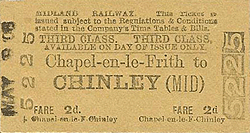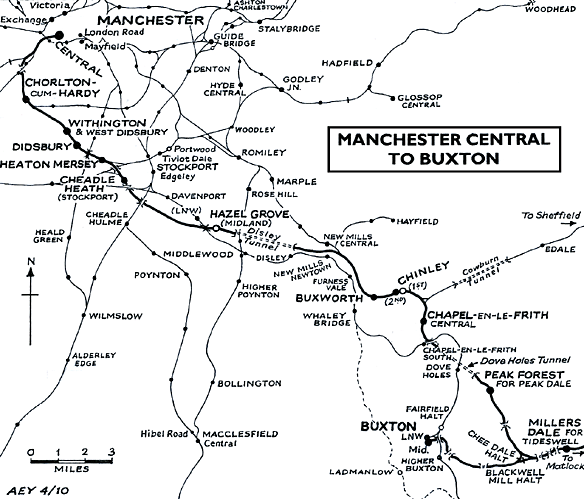Notes: Chapel-en-le-Frith Central station was located on the Midland Railway (MR) main line route that ran between Manchester Central and Ambergate.
The MR had opened a line in stages between Ambergate and Buxton by the 1st June 1863. However the company’s real goal was to get to Manchester. The original idea had been for the line to continue westwards from Buxton but opposition from the London North Western Railway (LNWR) and geological factors forced the MR to think again.
 |
As the line to Buxton was nearing completion the MR began to look for alternative routes. A route from Blackwell Mill, which lay to the east of Buxton, to Chinley and Marple looked favourable. During the Autumn of 1861 the MR chairman Mr Beale, along with the deputy Chairman Mr Hutchinson and the company general manager James Allport, were visiting |
the proposed route for the line which had been surveyed by company engineers. Whilst driving down a narrow lane they came across a cart which was carrying the Director and two officers of the Manchester Sheffield and Lincolnshire Railway (MSLR). The two groups got to talking and discovered that each was looking at the same route for a railway. Rather than waste time and energy competing against each other the group retired to a hostelry for food and drink. They spent the rest of the day together and reached an accord.
| The MSLR had recently received an Act that would allow it to build a line from Hyde near Manchester to New Mills. It was agreed that if the MR could build a line from Blackwell Mill to the proposed MSLR line then both companies would benefit. The MR could have a route to Manchester by using MSLR metals and the MSLR could have access to the Peak District and |
 |
beyond.
In 1862 an act was passed giving the MR authority to build a line from Blackwell Mill to Chinley and beyond to make an end on connection with the MSLR line at New Mills. The act was called the ‘Rowsley and Buxton Extension Line’.
Chapel-en-le-Frith had developed as a settlement as early as 1250 so the MR considered that it was an obvious location for a station. Construction of the station was carried out during 1866 and the line opened to good traffic on 1st October 1866. Passenger services were to have commenced on 1st November, but a landslip at Bugsworth resulted in its closure while a new deviation was constructed. The line re-opened for goods traffic on 24th January 1867 and to passenger traffic on 1st February.
| The station was located on the west side of its village namesake on the west side of what became Station Road. It was provided with two platforms the southbound of which was linked to the village by an access road. The main station building which was built to the same design as the station at Bakewell, but with a higher pitched roof, was located on the southbound |
 |
platform. The building was a stone single storey structure that was provided with all of the usual amenities that could be expected of a 19th century station. The station building also had a canopy on its platform side that gave protection from the elements. On the northbound platform a matching canopy was provided. At the time of opening passengers had to cross the line from one platform to the other by means of a barrow crossing.
 |
Chapel-en-le-Frith station was also provided with a goods yard which was located on the west side of the line behind the northbound platform. The goods yards included a stone goods shed with 1 ton 10 cwt crane and facilities for handling cattle as the village was the location of an important cattle market. There were two loop sidings, one passing through the goods shed and a third siding. The signal box was on the southbound platform.
At the time of opening Chapel-en-le-Frith station was served by a mixture of local and long distance trains running between Manchester and Derby or Buxton and even onwards to London. By 1872 there were just under 25,000 passenger bookings annually at Chapel-en-le-Frith making it one of the busiest stations between Chinley and Ambergate.
In 1886 a waiting shelter was constructed on the |
northbound platform. In 1905 two signal boxes that had been located to the north and to the south of the station were replaced by one which was built at the north end of the southbound platform; their replacement was estimated to have saved £235pa in signalmen’s wages.A couple of years later the main lines through the station were spaced at a wider distance apart and the station's platforms were rebuilt. As part of the platform rebuilding they were made higher being built to 3ft above track level.
| By 1913 Chapel-en-le-Frith station was being used by 200 passengers per day. Because passengers were having to cross the line by a barrow crossing, which on a busy main line was a dangerous situation, the MR made funds available for the construction of a covered footbridge. The footbridge was built at the northern end of the main station building. |
 |
By 1922 there were over 55,000 passenger bookings per year at the station which was served by 23 stopping trains on weekdays. Services ran to Manchester Central, Chinley, Derby and Buxton.
In 1923 Chapel-en-le-Frith Station became part of the London Midland Scottish Railway (LMS) who renamed it as Chapel-en-le-Frith Central on the 2nd June 1924. The reason for the renaming was that there was another station nearby which had been part of the LNWR and was also called Chapel-en-le-Frith. It was renamed as Chapel-en-le-Frith South.
By 1935 Chapel-en-le-Frith Central was being served by 29 train services, 14 going north and 15 going south. Services ran to Manchester Central, Chinley, Derby, Nottingham and Buxton. During the Second World War passenger services were cut back to 7 southbound services and 6 northbound.
On the 1st January 1948 Chapel-en-le-Frith Central station became part of the nationalised British Railways (London Midland Region). Train services never recovered to their pre war levels and increasing road competition started to reduce passenger numbers. Never the less by the mid 1950s passengers at Chapel-en-le-Frith Central could travel to the usual destinations plus Liverpool. Short distance runs to Chinley which gave connections into London St Pancras services were also run at this period.
 |
Goods lines were withdrawn on 2nd December 1963. The 1963 Beeching report recommended the closure of all the intermediate stations between Matlock and Chinley. They all closed to passenger services, including Chapel-en-le-Frith on the 6th March 1967. Express passenger services continued to pass through for one more year ceasing in 1968. On the 30th of |
June 1968 goods facilities at Chapel-en-le-Frith were taken out of use and the platform located signalbox closed.
The line through the station remained open as far as Buxton only. The section between Blackwell Mill and Matlock closed in 1968 and was lifted in 1969. Heavy stone traffic has ensured the survival of the line through the station site to this day. After closure the platforms were demolished along with the footbridge and all structures on the southbound platform. The main station building, minus its canopy, has survived and is in use as a DIY centre.
Notes on tickets
From the 1850s to 1917, 3rd Class fares on British railways were based on 1d per mile. However, in cases where there was direct competition between two companies, the one with the longer route usually reduced its fares to that of its competitor.
| Chapel-en-le-Frith to Buxton was one such case. Here the distance via the L&NWR route was just 5 and a quarter miles, whereas a direct journey via the Midland route was almost twice as far at 10 and a quarter miles. It would have been commercial suicide for the Midland to have charged more than the L&NWR, so it too charged 5d. Ticket 7086 illustrates |
 |
this feature. However, the layout is quite different from most tickets of the period in that it contains extended conditions which state that if the passenger alighted at an intermediate station he would have to pay the difference between the amount paid and the normal fare to that station. This did not mean Peak Forest, as it was only 2 and a half miles from Chapel, but was really to discourage passengers travelling to (or via) Millers Dale rather than on a direct service between the two stations. Ticket 6434 shows that the fare from Chapel-en-le-Frith to Millers Dale, based on the strict 1d per mile basis, was 8d at this time.
A Midland Railway season ticket from Manchester Central to Chapel-en-le-Frith. This is somewhat unusual as you would normally expect a ticket from Manchester Central to be a Cheshire Lines Committee print. It probably bore the Midland title due to the fact that it was also available for through journeys from Manchester London to the L&NWR station at Chapel-en-le-Frith, a feature of the 1908 agreement between the two companies which allowed journeys to be made on either company’s trains where duplicated routes existed.
Through Limestone Hills by Bill Hudson. Published by OPC 1989 ISBN 978-0860932178
Other web sites: Peak Rail now providing a regular steam service between Matlock and Rowsley. David Hey's Collection - Transition from BR steam. Includes railway photographer ER Morten's photographic tour from Buxton - Derby.
Further reading: Railway from Buxton to Bakewell, Matlock and Ambergate (Scenes from the Past) by JM Bentley, 1992. Railways around Buxton by JM Bentley, 1987.
Additional source Glynn Waite. Tickets from Michael Stewart and Glynn Waite notes on tickets by Glyn Waite, route map drawn by Alan Young
To see other stations between Manchester Central & Matlock click on the station name:Manchester Central, Chorlton-cum-Hardy, Withington & West Didsbury, Didsbury, Heaton Mersey, Cheadle Heath, Hazel Grove (Midland), Buxworth, Chinley (2nd site) STILLOPEN, Chinley (1st site), Peak Forest, Cheedale Halt, Buxton (Midland), Blackwell Mill Halt, Millers Dale, Monsal Dale,
Great Longstone, Hassop, Bakewell, Rowsley (Second site), Rowsley (First site), Rowsley South PEAK RAIL, Darley Dale, Matlock Riverside PEAK RAIL & Matlock STILL OPEN. See also Stockport Tiviot Dale & Stockport Portwood |

)frith_old5.jpg)


)frith_old2.jpg)
stationsuk1960)frith_old1.jpg)
2.jpg)
11.jpg)









)frith_old_thumb4.jpg)
e_frith_old_thumb7.jpg)

)frith_old_thumb3.jpg)
thumb1.jpg)
thumb3.jpg)
thumb4.jpg)
thumb5.jpg)
thumb6.jpg)
thumb7.jpg)
thumb8.jpg)
thumb9.jpg)
thumb10.jpg)

 Home Page
Home Page